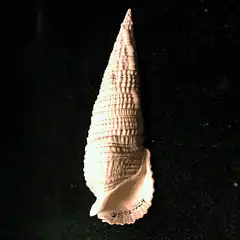| Tamiami Formation | |
|---|---|
| Stratigraphic range: Late Miocene-Late Pliocene ~ | |
 Fossil (Cerithium dalli) from the Tamiami Formation | |
| Type | Geological formation |
| Sub-units | Buckingham Limestone Member, Ochopee Limestone Member, Bonita Springs Marl Member, Golden Gate Reef Member, Pinecrest Sand Member |
| Overlies | Hawthorn Group (see text) |
| Thickness | 50–100 ft (15–30 m) |
| Lithology | |
| Primary | Sandstone, claystone, limestone |
| Other | Phosphate |
| Location | |
| Region | Southwest Florida |
| Country | |
| Extent | Charlotte-Monroe Counties |
| Type section | |
| Named for | Tamiami Trail (highway) |
The Tamiami Formation is a Late Miocene to Pliocene geologic formation in the southwest Florida peninsula.[1]
Age
Period: Neogene
Epoch: Late Miocene to Pliocene
Faunal stage: Clarendonian through Blancan ~13.06–2.588 mya, calculates to a period of 10.472 million years
Location

The Tamiami Formation appears in the counties of Charlotte, Lee, Hendry, Collier and Monroe. It is widespread in Florida and part of the intermediate confining aquifer system.[2] The Tamiami formation overlies the Hawthorn at every locality where the Hawthorn has been penetrated and is overlain unconformably by the Caloosahatchee marl of the Pliocene in Charlotte County.
Composition
The Tamiami Formation contains a wide range of mixed carbonate-siliciclastic lithologies and associated faunas. It occurs at or near the land surface in the southern peninsula with numerous named and unnamed members recognized within the Tamiami Formation. Its unevenness indicates that the upper part has been subjected to erosion.[3]
Lithologies
The Tamiami Formation includes:
- light gray to tan, unconsolidated, fine to coarse grained sand with fossils
- light gray to green, poorly consolidated, fossil bearing sandy clay to clayey sand
- light gray, poorly consolidated, very fine to medium grained, calcareous, fossil bearing sand
- white to light gray, poorly consolidated, sandy, fossil bearing limestone
- white to light gray, moderately to well hardened, sandy, fossiliferous limestone
Phosphate is present in limited quantities throughout the Tamiami in sand and gravel.
Sub-units
- Bonita Springs Marl Member
- Golden Gate Reef Member
- Ochopee Limestone Member
- Pinecrest Sand Member
Fossils
Fossils appear in casts and molds, as well as original material.
- Barnacles
- Mollusks (Ostrea disparilis, Chione ulocyma, and Turritella pontoni)
- Corals
- Echinoids
- Foraminifers
- Nanoplankton (calcareous)
References
- ↑ Parker, Garald G., 1951, Geologic and hydrologic factors in the perennial yield of the Biscayne aquifer: Jour. Am. Water Works Assoc., v. 43, no. 10, p. 817–834, 7 figs.
- ↑ Mansfield, W. C., 1939, Notes on the upper Tertiary and Pleistocene mollusks of peninsular Florida: Florida Geological Survey Bulletin 18, 75 p.
- ↑ Missimer, T.M., 1992, Stratigraphic relationships of sediment facies within the Tamiami Formation of southwestern Florida: Proposed intraformational correlations; in Scott, T.M., and Allmon, W.D., (eds.), The Plio-Pleistocene stratigraphy and paleontology of southern Florida; Florida Geological Survey Special Publication 36, p. 63–92.
Further reading
- Finch, J., Geological essay on the Tertiary formation in America: American Journal of Science, v. 7, p. 31–43, 1823.
- Berkenkotter, Richard D, Application of statistical analysis in evaluating bedded deposits of variable thickness—Florida phosphate data (United States. Bureau of Mines. Report of investigations, U.S. Dept. of the Interior, Bureau of Mines (1964)